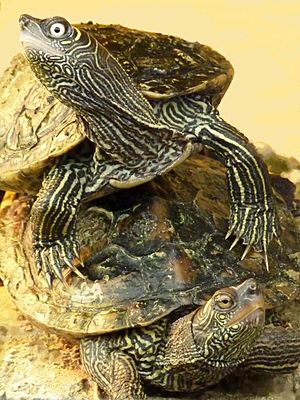Mississippi map turtle facts for kids
The Mississippi map turtle (scientific name: Graptemys pseudogeographica kohni) is a type of turtle that lives in both land and water. It belongs to the Emydidae family, which includes many common turtles. This turtle is special because it's only found naturally in the central United States.
Map turtles, which belong to the Graptemys group, get their name from the cool lines and patterns on their shells. These markings look a lot like the contour lines you see on a map! You can find different kinds of map turtles in the Mississippi Valley, from places like Illinois and Nebraska, all the way south to states near the Gulf of Mexico, like Mississippi and Texas. They usually live in rivers, lakes, and big streams, and they really like places with lots of plants.
Quick facts for kids Graptemys pseudogeographica kohni |
|
|---|---|
 |
|
| Top: Mississippi Map Turtle; Bottom: False Map Turtle | |
| Conservation status | |
| Scientific classification |
|
| Kingdom: | Animalia |
| Phylum: | Chordata |
| Class: | Reptilia |
| Order: | Testudines |
| Suborder: | Cryptodira |
| Family: | Emydidae |
| Genus: | Graptemys |
| Species: | |
| Subspecies: |
G. p. kohni
|
| Trinomial name | |
| Graptemys pseudogeographica kohni (Baur, 1890)
|
|
| Synonyms | |
|
|
What's in a Name?
The Mississippi map turtle gets its common name not from the state of Mississippi, but from the mighty Mississippi River itself.
The second part of its scientific name, kohni, honors a natural history enthusiast named Joseph Gustave Kohn (1837-1906). He was from New Orleans, Louisiana, and he collected the very first example of this turtle that scientists studied.
Where Do They Live?
You can find the Mississippi map turtle, Graptemys pseudogeographica kohni, along the Mississippi River and the smaller rivers that flow into it. Their home range stretches from Illinois and Missouri down towards the south. There was even one reported to be found in South Lyon, Michigan!
How to Spot Them
Female Mississippi map turtles are much bigger than the males. An adult male's shell is usually about 3.5 to 5 inches (9 to 13 cm) long. An adult female's shell can be from 6 to 10 inches (15 to 25 cm) long.
Males tend to look slimmer, more like young turtles. Females, however, have a larger, more solid build. Their shells are usually gray and covered with yellow lines that look like the contour lines on a map.
Mississippi Map Turtles as Pets
The Mississippi map turtle is a popular choice for people who keep aquariums. They are very interesting and fun to watch!


